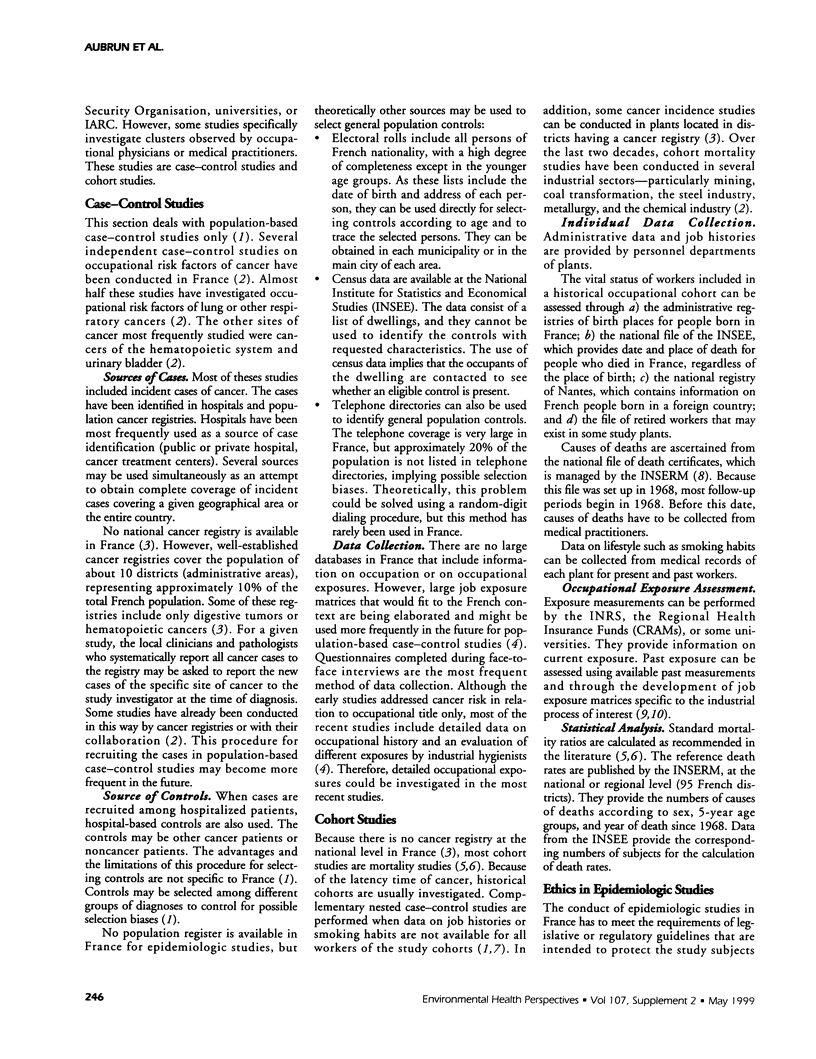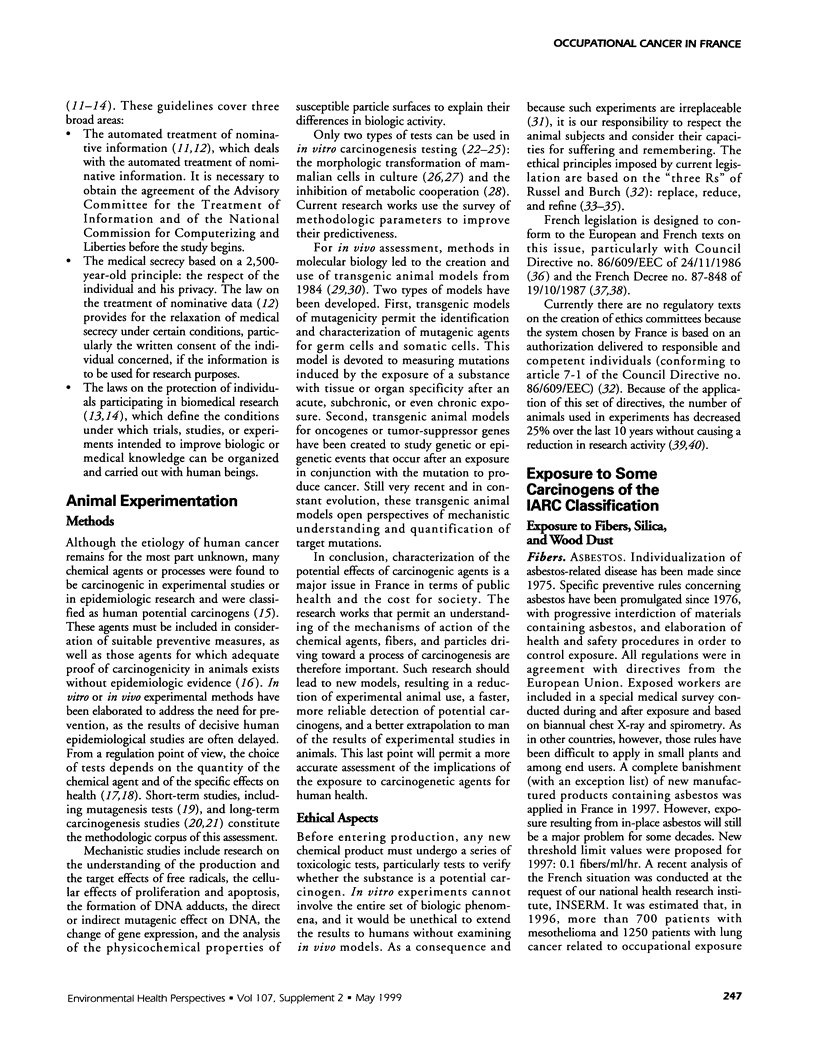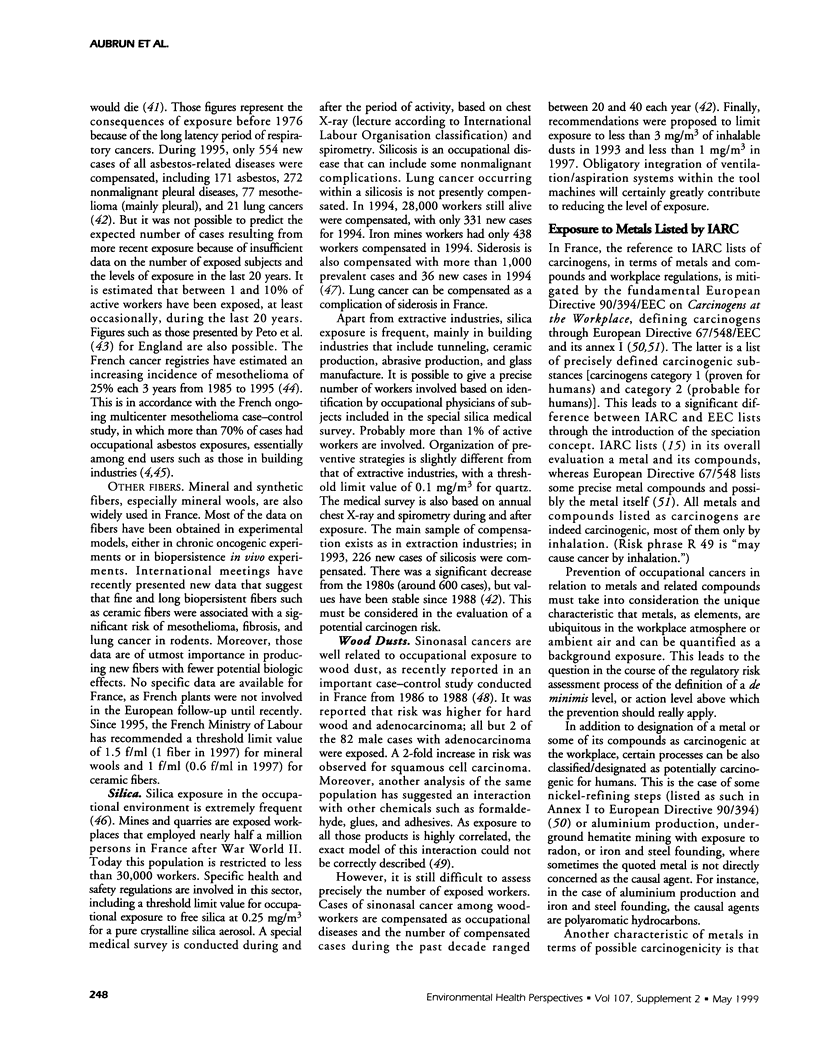Abstract
This article is a description of the current situation in France with regard to occupational cancer: research, prevention, and occupation. Toxicologic experiments are carried out using (italic)in vitro(/italic) and (italic)in vivo(/italic) tests, particularly using transgenic mice. Several epidemiologic studies have been conducted over the last decades: population-based case-control studies; mortality studies and cancer incidence studies carried out in historical cohorts of workers employed in the industry; and case-control studies nested in occupational cohorts. French ethical aspects of toxicologic and epidemiologic studies are described. The results thus obtained are used to establish regulations for the prevention and the compensation of cancers attributable to occupational exposure. This French regulation for prevention of occupational cancer involves several partners: (italic)a(/italic)) the states authorities, including labor inspectors, responsible for preparing and implementing the labor legislation and for supervising its application, particularly in the fields of occupational health and safety and working conditions; (italic)b(/italic)) the Social Security Organisation for the analysis of present or potential occupational risks based on tests, visits in plants, complaints or requests from various sources, and statistics. These activities are performed within the framework of the general French policy for the prevention of occupational cancer. This organization includes the National Institute for Research and Safety, particularly involved in research in the various fields of occupational risks--animal toxicology, biologic monitoring, exposure measurements epidemiology, psychology, ergonomy, electronic systems and machineries, exposure to chemicals, noise, heat, vibration, and lighting; and (italic)c(/italic)) companies where the regulation defines the role of the plant manager, the occupational physician, and the Health, Safety and Working Conditions Committee (comprising the manager, employees' representatives, the occupational physician, and the safety department) in dealing with any problem regarding safety, occupational hygiene, and working conditions. These organizations along with medical practitioners are involved with the compensation of occupational cancers. The regulation for compensation includes the tables of occupational cancer, the possibility of recognition of a cancer case when the requirements of the tables are not met, and the postprofessional follow-up of workers exposed to a carcinogenic agent.
Full text
PDF







Selected References
These references are in PubMed. This may not be the complete list of references from this article.
- Ashby J., Tennant R. W. Definitive relationships among chemical structure, carcinogenicity and mutagenicity for 301 chemicals tested by the U.S. NTP. Mutat Res. 1991 May;257(3):229–306. doi: 10.1016/0165-1110(91)90003-e. [DOI] [PubMed] [Google Scholar]
- Balls M. Replacement of animal procedures: alternatives in research, education and testing. Lab Anim. 1994 Jul;28(3):193–211. doi: 10.1258/002367794780681714. [DOI] [PubMed] [Google Scholar]
- Brugère J., Thébaud-Mony A., Pézerat H., Cassou B. Cancers professionnels: connaissance, réparation et prévention. Bull Cancer. 1994 Jan;81(1):14–21. [PubMed] [Google Scholar]
- Coleman M., Douglas A., Hermon C., Peto J. Cohort study analysis with a FORTRAN computer program. Int J Epidemiol. 1986 Mar;15(1):134–137. doi: 10.1093/ije/15.1.134. [DOI] [PubMed] [Google Scholar]
- Dhalluin S., Elias Z., Cruciani V., Bessi H., Poirot O., Rast C., Gate L., Pages N., Tapiero H., Vasseur P. Two-stage exposure of Syrian-hamster-embryo cells to environmental carcinogens: superinduction of ornithine decarboxylase correlates with increase of morphological-transformation frequency. Int J Cancer. 1998 Mar 2;75(5):744–749. doi: 10.1002/(sici)1097-0215(19980302)75:5<744::aid-ijc13>3.0.co;2-6. [DOI] [PubMed] [Google Scholar]
- Elias Z., Poirot O., Schneider O., Marande A. M., Danière M. C., Terzetti F., Pezerat H., Fournier J., Zalma R. Cytotoxic and transforming effects of some iron-containing minerals in Syrian hamster embryo cells. Cancer Detect Prev. 1995;19(5):405–414. [PubMed] [Google Scholar]
- Festing M. F. Reduction of animal use: experimental design and quality of experiments. Lab Anim. 1994 Jul;28(3):212–221. doi: 10.1258/002367794780681697. [DOI] [PubMed] [Google Scholar]
- Flecknell P. A. Refinement of animal use--assessment and alleviation of pain and distress. Lab Anim. 1994 Jul;28(3):222–231. doi: 10.1258/002367794780681660. [DOI] [PubMed] [Google Scholar]
- Goldberg M., Leclerc A., Chastang J. F., Goldberg P., Brodeur J. M., Fuhrer R., Segnan N. Evaluation rétrospective d'expositions professionnelles dans les études épidémiologiques. Utilisation de la méthode Delphi. Rev Epidemiol Sante Publique. 1986;34(4-5):245–251. [PubMed] [Google Scholar]
- Goldsworthy T. L., Recio L., Brown K., Donehower L. A., Mirsalis J. C., Tennant R. W., Purchase I. F. Transgenic animals in toxicology. Fundam Appl Toxicol. 1994 Jan;22(1):8–19. doi: 10.1006/faat.1994.1002. [DOI] [PubMed] [Google Scholar]
- Iwatsubo Y., Pairon J. C., Archambault de Beaune C., Chamming's S., Bignon J., Brochard P. Pleural mesothelioma: a descriptive analysis based on a case-control study and mortality data in Ile de France, 1987-1990. Am J Ind Med. 1994 Jul;26(1):77–88. doi: 10.1002/ajim.4700260107. [DOI] [PubMed] [Google Scholar]
- Iwatsubo Y., Pairon J. C., Boutin C., Ménard O., Massin N., Caillaud D., Orlowski E., Galateau-Salle F., Bignon J., Brochard P. Pleural mesothelioma: dose-response relation at low levels of asbestos exposure in a French population-based case-control study. Am J Epidemiol. 1998 Jul 15;148(2):133–142. doi: 10.1093/oxfordjournals.aje.a009616. [DOI] [PubMed] [Google Scholar]
- Kogevinas M., Boffetta P. Occupational exposure to carcinogens and cancer occurrence in Europe. Med Lav. 1995 May-Jun;86(3):236–242. [PubMed] [Google Scholar]
- Leclerc A., Martinez Cortes M., Gérin M., Luce D., Brugère J. Sinonasal cancer and wood dust exposure: results from a case-control study. Am J Epidemiol. 1994 Aug 15;140(4):340–349. doi: 10.1093/oxfordjournals.aje.a117256. [DOI] [PubMed] [Google Scholar]
- Luce D., Gérin M., Leclerc A., Morcet J. F., Brugère J., Goldberg M. Sinonasal cancer and occupational exposure to formaldehyde and other substances. Int J Cancer. 1993 Jan 21;53(2):224–231. doi: 10.1002/ijc.2910530209. [DOI] [PubMed] [Google Scholar]
- Mirsalis J. C., Monforte J. A., Winegar R. A. Transgenic animal models for detection of in vivo mutations. Annu Rev Pharmacol Toxicol. 1995;35:145–164. doi: 10.1146/annurev.pa.35.040195.001045. [DOI] [PubMed] [Google Scholar]
- Moulin J. J., Romazini S., Lasfargues G., Peltier A., Bozec C., Deguerry P., Pellet F., Wild P., Perdrix A. Elaboration d'une matrice emplois-expositions dans l'industrie productrice de métaux durs en France. Rev Epidemiol Sante Publique. 1997 Mar;45(1):41–51. [PubMed] [Google Scholar]
- Moulin J. J., Wild P., Romazini S., Lasfargues G., Peltier A., Bozec C., Deguerry P., Pellet F., Perdrix A. Lung cancer risk in hard-metal workers. Am J Epidemiol. 1998 Aug 1;148(3):241–248. doi: 10.1093/oxfordjournals.aje.a009631. [DOI] [PubMed] [Google Scholar]
- Peto J., Hodgson J. T., Matthews F. E., Jones J. R. Continuing increase in mesothelioma mortality in Britain. Lancet. 1995 Mar 4;345(8949):535–539. doi: 10.1016/s0140-6736(95)90462-x. [DOI] [PubMed] [Google Scholar]


